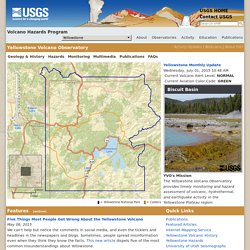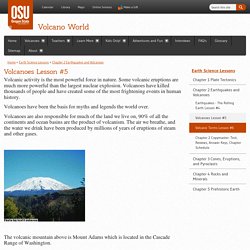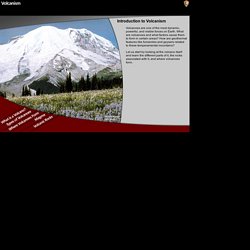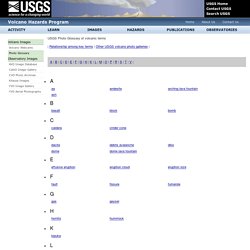

Anatomy of a Volcano. By Lexi Krock Posted 11.12.02 NOVA What's the difference between lava and magma?

What are volcanic vents, dikes, and fissures? In this anatomy of a volcano, explore the basic geological features of a volcano such as Mt. St. Helens as well as the deadly materials released during volcanic eruptions. To learn more about the various numbered parts of this volcano diagram, read on. There are many different kinds of volcanoes, ranging from the Hawaiian type, which produces gentle, effusive eruptions that tourists can observe from mere steps away, to the andesitic variety, which can produce violent, life-threatening eruptions with little warning. Many volcanoes famous for their destructive power, including Mt.
Mt. 1. Volcanic ash consists of rock, mineral, and volcanic glass fragments smaller than a tenth of an inch in diameter—or slightly larger than a pinhead. Ash from the 1993 eruption of Unzen volcano in Kyushu, Japan rises halfway up the walls of a house. 2. lava flow 3. lava dome. How Volcanoes Work. Volcano Hazards Program Yellowstone Volcano Observatory. Mh = Yellowstone National Park Yellowstone Monthly Update Wednesday, July 01, 2015 10:48 AM Current Volcano Alert Level: NORMAL Current Aviation Color Code: GREEN YVO's Mission The Yellowstone Volcano Observatory provides timely monitoring and hazard assessment of volcanic, hydrothermal, and earthquake activity in the Yellowstone Plateau region.

Five Things Most People Get Wrong About the Yellowstone VolcanoMay 08, 2015 We can't help but notice the comments in social media, and even the ticklers and headlines in the newspapers and blogs. Sometimes, people spread misinformation even when they think they know the facts. Seismic research finds two magma storage regions beneath YellowstoneApril 23, 2015 Researchers at the University of Utah and their colleagues at the University of New Mexico and Caltech released a paper in the journal Science on their latest imaging of the crust beneath Yellowstone using seismic techniques. NPS: Nature & Science» Geology Resources Division. Haleakala National Park, Hawaii Haleakala Crater is now a cool, cone-studded reminder of a once-active volcano.

Streaks of red, yellow, gray, and black trace the courses of recent and ancient lava, ash, and cinder flows. The volcanic rocks slowly break down as natural forces reduce them to minute particles which are swept away by wind, heavy rain, and intermittent streams. A fiery birth beneath the sea Modern geology indicates that the Hawaiian Islands are situated near the middle of the Pacific Plate, one of a dozen thin, rigid structures covering our planet like the cracked shell of an egg. Though adjoining each other, these plates are in constant slow motion, the Pacific Plate moving northwestward several centimeters per year. This constant northwestward movement of the Pacific Plate over a local volcanic "hot spot", or plume, has produced a series of islands one after another in assembly line fashion.
Ultimately these two valleys met, creating a long erosional "crater". Earthguide Online Classroom - Convection. Hotspots [This Dynamic Earth, USGS] The vast majority of earthquakes and volcanic eruptions occur near plate boundaries, but there are some exceptions.
![Hotspots [This Dynamic Earth, USGS]](http://cdn.pearltrees.com/s/pic/th/hotspots-this-dynamic-earth-111897791)
Oregon State University. The volcanic mountain in this picture is Mayo Volcano on the island of Luzon in the Philippines.

Mayon is a beautiful example of a stratovolcano. This is a model of the interior and exterior of a stratovolcano. The letters represent important terms that you need to know to understand how volcanoes are formed and how they work. The letter A represents a magma chamber. Magma is molten rock that is located under the surface of the Earth. The magma is less dense and under extreme pressures that force it up toward the surface. The letter B represents a Dike. A dike is an intrusion of magma that cuts through layers of already existing rock. Oregon State University. Volcanic activity is the most powerful force in nature.

Some volcanic eruptions are much more powerful than the largest nuclear explosion. Volcanoes have killed thousands of people and have created some of the most frightening events in human history. Volcanoes have been the basis for myths and legends the world over. Undersea Volcano Eruptions Caught On Video. PBS Media Volcanism.
Volcanoes are one of the most dynamic, powerful, and visible forces on Earth.

What are volcanoes and what factors cause them to form in certain areas? How are geothermal features like fumaroles and geysers related to these temperamental mountains? Yellowstone Caldera : The Biggest Volcanic Eruption Ever Awaits Mankind. USGS Alert:Magma Levels rising in Mount St. Helens volcano. Volcano Hazards Program. Volcano Hazards Program Webcams. USGS Photo Glossary of volcanic terms. Volcano Hazards Program USGS Photo Glossary of volcanic terms | Relationship among key terms | Other USGS volcano photo galleries | Relationship among key terms Other USGS volcano photo galleries USGS earthquake image glossary courtesy of USGS Earthquake Hazards Program.

Oregon State University. Smithsonian Institution - Global Volcanism Program: Worldwide Holocene Volcano and Eruption Information.